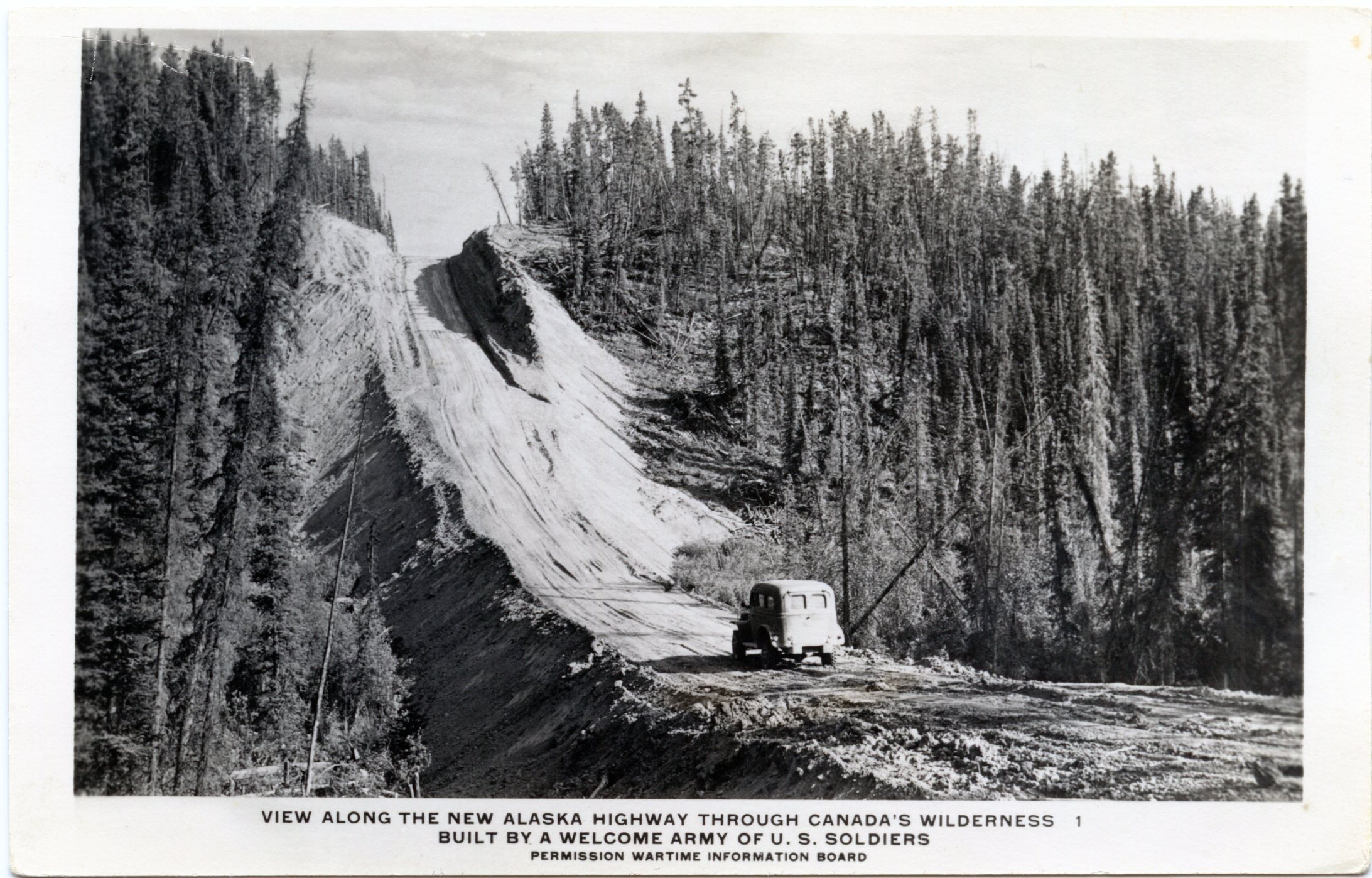 Postcard of Suicide Hill Courtesy Fort St. John North Peace Museum I986.27.06
Postcard of Suicide Hill Courtesy Fort St. John North Peace Museum I986.27.06
Driven by wartime urgency, the building of the Alaska Highway remains an epic accomplishment, decades later.
The highway began as a dream.
In the 1920s, the United States wanted a route through Canada to connect Alaska – its largest and most sparsely populated territory – with the 48 states south of the 49th parallel. Some 800 kilometres of land lay between Alaska and the rest of the US. With no overland way across northern BC and the Yukon to Alaska, the northernmost US state was reliant on air and marine transport.
Back then, Canada was just not interested – there was little to be gained, and the next decade brought the Great Depression.
Wartime Drive
That all changed when the Japanese bombed Pearl Harbour, Hawaii, on Dec. 7, 1941. The US entered the Second World War and a supply and defence route became critical to both nations. Canada agreed to building of the Alaska-Canada highway, on the condition that the United States foot the bill, and that the route be turned over to Canada after the war.
In March 8, 1942, hundreds of pieces of construction equipment arrived by train at Dawson Creek. More than 10,000 American soldiers were stationed by US Army Corps of Engineers, in Alaska, BC and the Yukon, to build the highway starting from different locations.
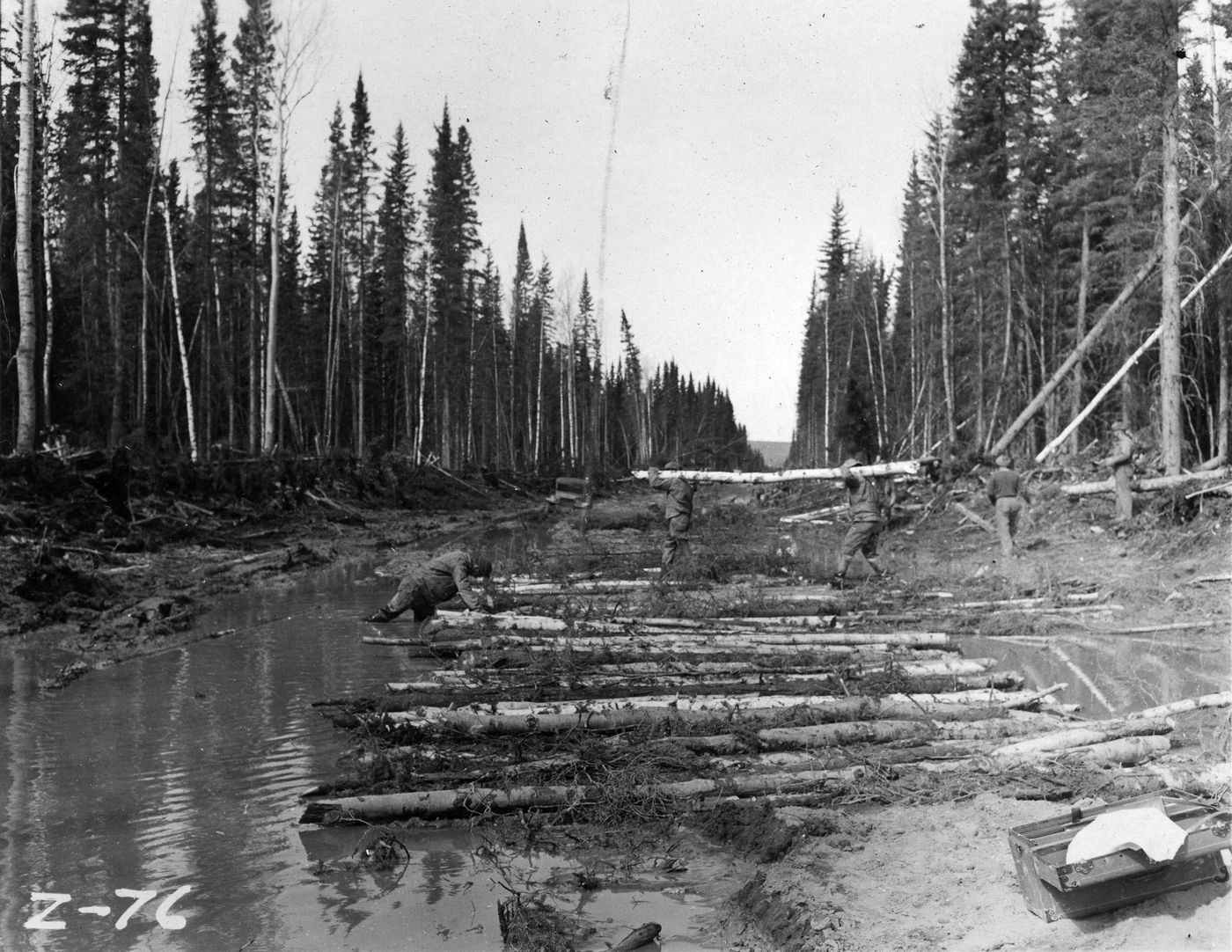 Roadbuilding through the northern bush. U.S. Army Corps of Engineers
Roadbuilding through the northern bush. U.S. Army Corps of Engineers
A Dream or a Nightmare?
If the highway was a dream come true, the making of it was a nightmare. The northern winter was harsher than most of the soldiers had ever known or could have imagined. The summer brought sweltering temperatures, choking dust and bloodthirsty masses of mosquitoes and blackflies.
Winter temperatures were hard on soldiers and machinery alike. “Cold weathe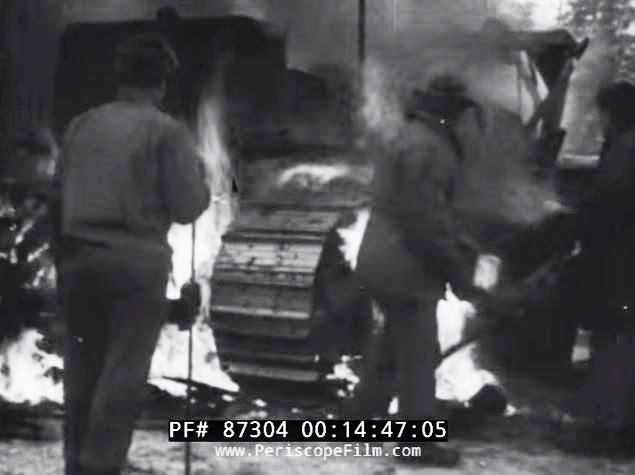 r threatens the steady progress of road building,” said the legendary Lorne Greene narrator of “Pincers on Japan“, a 1944 documentary, made by the National Film Board of Canada. “Ice clogged wheels, engines and treads at 40 degrees below zero, and they need drastic treatment to keep them free and rolling. Repair crews build fires under the frozen cats (machinery) and feed the flames with oil.”
r threatens the steady progress of road building,” said the legendary Lorne Greene narrator of “Pincers on Japan“, a 1944 documentary, made by the National Film Board of Canada. “Ice clogged wheels, engines and treads at 40 degrees below zero, and they need drastic treatment to keep them free and rolling. Repair crews build fires under the frozen cats (machinery) and feed the flames with oil.”
The soldiers worked seven days a week pushing a road through unmapped forest and bush, and around mountains. With the extra “daylight” of the midnight sun lasting 24 hours, crews worked double shifts, and 643 kilometres of highway were laid down in July alone.
“They worked as they have never worked before,” says Greene. “The days bring no recreation – nothing but work and sleep and food and the endless forest…But always the men move on, making time, fighting to finish the road, the vital avenue of supply and defence for ultimate attacks from across the Pacific. Image from “Pincers on Japan,” National Film Board of Canada
Making Roads on Muskeg
The 2,400-kilometre long route from Dawson Creek, BC, through the Yukon, and onto Delta Junction, Alaska was selected over an easier one proposed earlier, that would have started from Prince George. Military strategists picked it to connect with a series of airfields just built by the Canadian army between Edmonton and Whitehorse. However, the highway’s chosen route through the Northern Rockies wasn’t popular with everyone…
“The Alaska Highway winding in and winding out, fills my mind with serious doubt, as to whether the lout that planned this route, was going to hell or coming out!” – Retired Sergeant Troy Hise, stationed at Summit Lake, Historical Mile 392
Possibly, the most frustrating factor was the muskeg, decaying swamps of vegetation which could – and did – swallow roadbuilding equipment whole. Attempts were made to “corduroy” over the soggy ground with felled trees, and cover the trees with fill. Some corduroy sections were up to 15 feet deep.
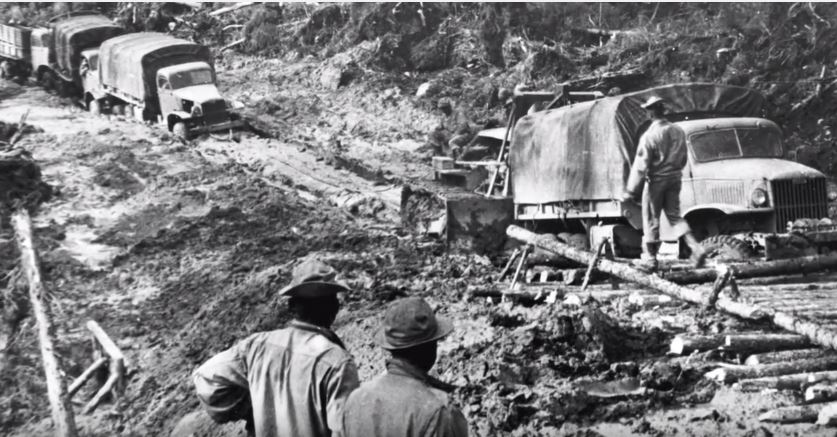 The challenges of northern construction and corduroy roads U.S. Army Corps of Engineers
The challenges of northern construction and corduroy roads U.S. Army Corps of Engineers
Road building on northern terrain was new to the engineers who discovered that when they removed the ground cover, the permafrost below would melt, and sink the road and machinery. They then changed the construction method to covering over the exposed road base with fill, before thawing could start. Although plans were to build the route 36 feet wide the first year, it was actually only 12 to 18 feet, according to a video from the Milepost.
A Route to Desegregation
About a third of the US soldiers who worked on the highway were African American, and for them, the hardships were exponential. In addition to working and living separately from the other soldiers, they were segregated from local communities, and did not receive the same calibre of equipment as the others, often working with hand tools instead of machinery. They mostly slept in tents while the other soldiers more often had wooden housing.
Despite this discrimination, the three African American regiments made an outstanding contribution and their efforts have been credited as a catalyst for desegregation of the US military in 1948. About 75 years later, the Alaskan State senate recognized their service with “African American Soldiers’ Contribution to Building the Alaska Highway Day.”
Their story is also being researched by acclaimed Canadian author Lawrence Hill.
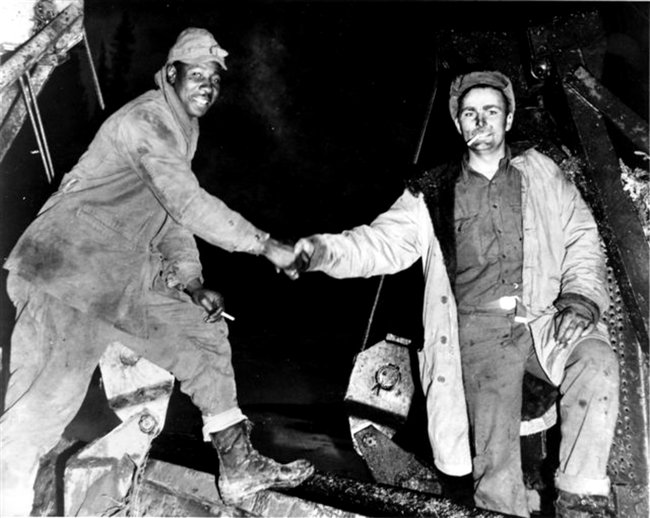 Soliders Refines Sims Jr. and Alfred Jalufkamet meet in the middle at Contact Creek, on completion of the Alaska Highway. U.S. Army Corps of Engineers
Soliders Refines Sims Jr. and Alfred Jalufkamet meet in the middle at Contact Creek, on completion of the Alaska Highway. U.S. Army Corps of Engineers
Construction Continued
When the Alaska Highway was finished on Sept. 24, 1942 in less than eight months, it was extremely crude. Called the “Alcan Highway” then, it offered temporary log bridges, steep grades, a poor road surface, few guardrails, and almost endless switchbacks among the hilly and mountainous terrain (though some speculate the road’s twists and turns were intentional to avoid strafing from enemy aircraft above.)
The army then turned the road over to the US Public Roads Administration, which hired private road contractors to upgrade selected sections of the road, and install steel bridges. In 1946, the Canadian section was transferred to the Canadian army.
Opened to the Public (Finally)
In 1948, the route was opened to the public. A rousing 1957 Chevrolet commercial “Champs of the ALCAN Run” shows it was still a tough, rough and unpredictable journey: “The lightening flashed, the hailstorm crashed. The rain turned the road into paste. We drove our band through that washed out land and into the Yukon waste. So we made our push through the Arctic bush, on that ribbon of mountainous road. And we held our stride on that rugged ride, in spite of the heavy load.”
Things improved in the 1960s and 1970s, when the provincial government paved from Mile 0 at Dawson Creek, to Mile 83, and eventually the remainder of the route to Delta Junction, Alaska was hard surfaced. The Canadian portion is now managed in sections by the BC Ministry of Transportation and Infrastructure, the federal government and the Yukon government.
Today, the Alaska Highway is fully paved and accommodates all kinds of travellers – from commercial traffic, to caravans of recreational vehicles that yearly carry more than a 100,000 tourists north for an epic wilderness journey. Gone are many of the switchbacks, the gravel surface (except for areas under improvement) and the bumper stickers that once proclaimed, “I Drove the Alaska Highway and Survived.”
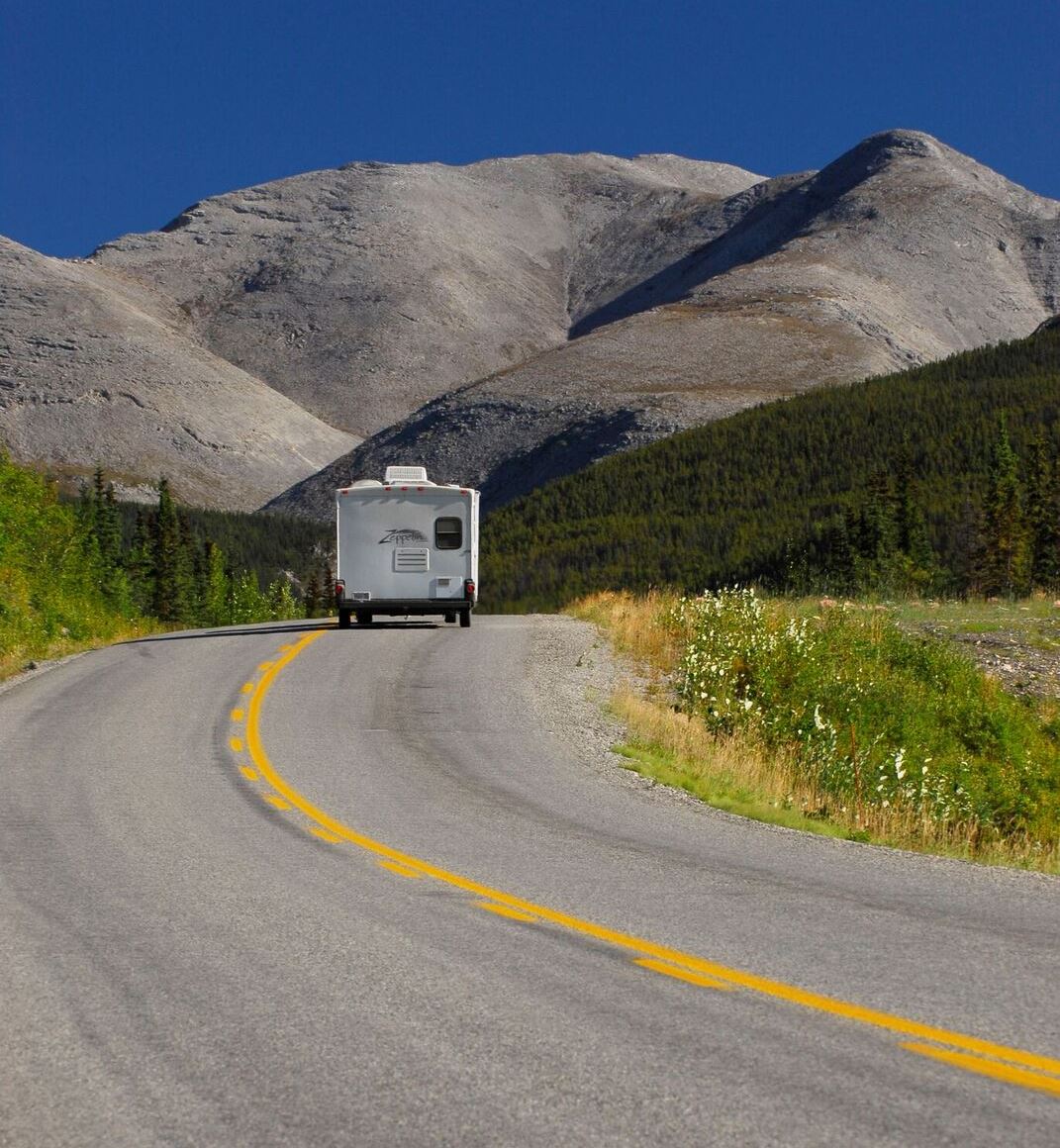 A smoother ride these days. Courtesy JF Bergeron
A smoother ride these days. Courtesy JF Bergeron
What was once driven by dire wartime concerns for security and freedom, the Alaska Highway is now a supply route to industry, a lifeline to communities and a road to adventure for explorers. The heroic efforts by a group of men decades years ago, who built a 2,400-kilometre route through wilderness and extraordinary hardships, in only eight months, will always be the foundation of this storied route.
Check out more fascinating information about this historic and awesome engineering achievement, including a 1944 documentary produced by the U.S. Army, a US War Department film highlighting construction, a video produced by the U.S. National Park Service showing bridge building by soliders wading chest-deep in water and listings of celebratory events planned for this summer.
We acknowledge the many sources of information for this article – which include National Geographic, the Milepost, the National Film Board of Canada, Military Officers’ Association of America, The US Department of Defence, The U.S. Army Corp of Engineers, The Alaska Highway 75th Anniversary Group, History Net (J. Kingston Pierce ) and Lisa Bush.
Although the Canadian spelling of harbour has a U in it, Pearl Harbor as mentioned in the article, since it is a place name, should use the American spelling, without the U.
Karl, thanks for pointing this out. I have corrected this to “Pearl Harbor” in the blog to reflect the location’s proper spelling.
For this heroic act I do not recall my father ever receiving a medal for his service in the RCAF.
Little known is that Canadian Greyhound suppled 12 MCI Coaches built in Winnipeg, along with Canadian mechanics and drivers in 1942 – 43 who could handle ice, snow and mud on a track under construction through the bush – because the US Army drivers couldn’t handle that tough driving.
Canadian Greyhound set up a schedule from Dawson Creek BC to Fairbanks Alaska.
Little known because the Canadian built coaches were flagged “Northwest Service Command “ so few knew they were all Canadian.
Thanks for sharing this, Tom!
My dad was a member of the Canadian Military From 1953 to 1965.
He immigrated from England, with my Mom and 2 Brothers.He Then Trained as an Engineer then started working on the Alaska Hiway shortly after his arrival.
We as a family lived in Watson Lake ,Chiliwack,BC, where I was Born,Whitehorse,Yukon and had brief stays in Fairbanks and Anchorage,Alaska . I always feel proud of my Dad and His Courage.
As you should, Sarah! Thank you for sharing. 🙂
Looking through old family photos, and finding some from when my Grandpa helped build this. It’s so amazing.
So nice to hear this, Cheryl. How wonderful that you have photos of his work to help build this important road. You must be proud. We love hearing from folks who have a personal connection to our highways. Take care and safe travels.
Cheryl,
Very cool. My dad worked on the ALCAN and then served in the Marines in WWII. We have a lot of photos taken during the construction…form my dad’s and 2 of his buddies that worked with him. We have one of dad standing at the original sign post at Watson lake.
Do you know how many soldiers lost their life to build the highway.
Hi Bobbie,
Thanks for connecting with us here. Unfortunately, we don’t know that statistic but here is a link to a page with more information: http://www.explorenorth.com/alaska_highway/alaska_highway-graves_and_memorials.html
During this era, the music was predominantly by the big bands, and typical of the genre were such popular artists as Benny Goodman, Glenn Miller, and Tommy Dorsey.
The United States just entered World War II, and our father, a Staff Sgt. in the U. S. Army, and his military colleagues worked in a temporary facility (of which was the Army’s Finance Office in Dawson Creek) for the duration of the construction of the renowned Alaska Highway. He and his co-workers were an integral part of the procurement of this paramount project which began in March 1942.The 1,500 mile road was considered an amazing engineering feat in that it was completed under numerous adverse conditions, and in an incredibly short time span—just over eight months.
Thanks for sharing your story with us here, Elaine!
I went ”south from Anchorage. the road was in good shape. Not many gas stations along the way. I remember seeing a gal heading north in a 1 liter 3 cylinder Geo Metro, alone, I wanted to stop her and asked if she was ”crazy” Some short sections of dirt and gravel, but no problems
What a great site…….my memories of attending the one room school house at Summit Lake old army camp, many friends and neighbours, such as the DeMasters, Lafleurs and Marge and Dennie Collison of Toad River Lodge , and all the memories of growing up there. I miss it all to this day!!! My grandparents Frank and Delma owned and operated Summit Esso Services. A shame that the newer owners left it…..in such poor shape. I just have the good memories and photos!!!
Thank you,
Hi Julie! Thanks for the note and feedback – we just love hearing memories from people about it!
Back in 1972 a year out of high school on my return leg of a NYC to LA to Portland and back to NYC solo bicycle expedition, I took a “side trip” to Fairbanks via the Alcan Highway. I was in Spokane Washington speaking with a guy who said he was going to be riding his bike with his brother on a 900 mile dirt road to Alaska. I thought “wow! 900 miles on a dirt road to Alaska! I think I’ll do that! ” Remember, this was before the Internet and what info was there? Gas station road maps that’s it! Did it. Dry chocking dusty days from the big 18 wheelers passing and being pelted with stones and other debris, Wet muddy road days, and days of snow in late September … which I was ill prepared for, but hey, it’s an adventure! So it’s all good. 😎 Interestingly, in all the weeks I was on it I only saw some birds, and one woodchuck, no other wildlife.
Fast forward to the present. Recently I drove it round trip in a mini vanTo Fairbanks and then on to above the Arctic Circle. Beautifully straightened, paved nicely, much fewer services on it these days then in 1972, and don’t believe the nice blue signs on the road that indicate “Services 50 km” when you get there the places are closed and looks like they’ve been closed for years and years. when far north, always follow the policy “See Gas station? Top off the gas tank! ” but I digress … so the road surface now is so straight in places I was cruising some sections at 100mph … (OK folks, don’t go negative on me here)
RE: Wildlife? In a couple of days I saw deer, goats, bear, and several herds of bison walking down the road.
And I still have that bike, and am still riding it.
Bicycle is one of the best ways of SEEING the country.
Just read an article on The Dempster Highway …. Never been on it … Hmmmm …
😎
Thanks for sharing these awesome memories with us Will! So nice to hear about the increase in wildlife sightings too. 🙂
Just drove the Alaska Highway BOTH WAYS and am in awe of the sacrifices made by the men who constructed it.Especially the Regiment composed of African-Americans to have to sleep in tents!
Agreed – thanks for your comment James 🙂
This article misconstrued a number of details. The original highway was constructed by about 10,000 combat Engineers and MOST Of them slept in tents due to the crazy pace of construction of the highway (there wasn’t time to build permanent housing and it wasn’t practical due to the remoteness of the highway and the terrain). So no It wasn’t JUST the African American Regiments (93rd, 95th, 97th) and 388th battalion (around 3,000 men total) sleeping in tents, it was ALL the Engineers.
The building of the highway was often labor intensive for ALL the regiments (not just the African American units) due to how difficult it was to bring equipment in. That said, they did manage to bring in 174 stem shovels, 374 blade graders, 904 tractors, 5,000+ trucks, countless bulldozers, snowplows, cranes and generators (yes they had those in 1942) via the port of Valdez and by air from the Northwest Staging Route airfields.
Another detail often overlooked is the two other projects that paralleled the road (Canol Canadian Oil Pipeline and the Alaska Military Highway Telephone and Telegraph Line (AMHTTL)). These were critical projects for both Canada and the United States and was PART OF THE DEAL.
If you wish to read a more accurate account of the construction go to Alaska’s DOT website and search Alaska Highway 75 Anniversary.
Thanks for you comments and for sharing your perspectives of the complex and involved history of the building of the Alaska Highway, Chris. We do not claim to be historians, and we have drawn from a number of authoritative sources, which are acknowledged throughout the blog. As the blog states, the completion of the highway was a incredible achievement and enormous contributions were made by everyone involved. Thanks for your further details about the equipment brought in, under extremely challenging circumstances. Work on the Washington-Alaska Military Cable and Telegraph System in 1903, and the building of the Canol Road for the Canol Canadian Oil Pipeline were also huge efforts, however given our focus on work within the province of British Columbia, we chose to focus on the Alaska Highway.
HI, my father GILBERT VICTOR BATMAN, worked on the alcan highway from the beginning to the end with the engineers.He took many pictures in black and white also spectacular color slides. We saw pictures of the pet bears. He and my brother drove the alcan in the 70’s. Dad found artifacts of his old camps alone the way.Dad was very proud to be a part of the history.
Thank you for sharing the story of your father here with us Robert!
Hello I have read at this moment 10 books on the building of the high way . But I have been most interested where or how to find the rock markers of people that past building the high way .Is there some where that I have missed that has this information ? thank you for your time
Hi Ian – here’s a great start – the Alaska Milepost: https://www.themilepost.com/highways/alaska-highway/
Also this link has some memorials noted: http://www.explorenorth.com/alaska_highway/charlie_lake_memorial.html
Hope that this helps!
Thanks for linking to my pages at ExploreNorth – these memorials are a particular focus of my Alaska Highway passion.
I’m curious to know if there are any records of Canadian civilians that may have died while working on the construction of the Allan (Alaska) Highway, in 1942 in particular.
As the story was told, many decades later, it is entirely possible that my grandfather, Kaj Augusta Christian Pedersen, was killed by heavy equipment in 1924, during construction of the highway.
As there are no surviving relatives to confirm this, my family only has the story told by neighbours of my grandfather and none of them are alive anymore.
We have no further information and don’t know where to search to confirm this story. Any assistance you could give us in confirming this story as fact or fiction, would be greatly appreciated.
Thank you, in advance, for your help.
Hello Julie and thank you for contacting us here. Unfortunately, we do not have a list of workers who might have perished during construction. We encourage you to contact Transport Canada – as this was a federal initiative. We have also included a list of possible resources for you to research below. We hope that this helps and wish you all the best in your search for more information about your grandpa.
https://www.bac-lac.gc.ca/eng/discover/vital-statistics-births-marriages-deaths/births-marriages-deaths-recorded/Pages/search.aspx
https://www2.gov.bc.ca/gov/content/family-social-supports/seniors/health-safety/health-care-programs-and-services/vital-statistics
http://www.explorenorth.com/alaska_highway/alaska_highway-graves_and_memorials.html
https://www.chrisdennis111.com/category/land-route-to-alaska/alaska-highway-construction/
I was on the hi way when it was being built
Did ever know man you the name of Thomas Arnold? He was my father who help build it. I have several pictures of different men & friends he worked with there. I would someday like to be able to see it in person. My family talked about my father working on it. My Because there was such an age gap between him & my mom. He past away when I was only 13, so that would have been 47 yrs ago. So I don’t think u would have known him, but thought u may have remembered his name. Do they have a museum or anything like that with maybe the men who took part in building it, with their pictures or names on something. I would be very interested in getting some information on, if u may know something? Thank you!
Hi Lynn, there was a museum in Dawson Creek called Alaska Highway House. Unfortunately, it’s listed as “Temporarily Closed”. You might want to contact Tourism Dawson Creek at 900 Alaska Ave, Dawson Creek, BC,
V1G 4T6, Canada Tel: 250-782-9595 or Toll Free: 1-866-645-3022 for further information.
Hello My name is Lorne Lillico and my father was Gordon Lillico.
In 1941 my fathers Dad died of influenza in Baytree leaving my father, at 16, as the oldest of 8 kids. To make ends meet and do his part for the war Dad signed up at 16 of age, to go fight the war. They do not send 16 year old to battle so they signed him with the United States Army Engineers in northern BC. He was to assist the US forces in building the Alcan Highway. He worked on the road from 1941 to 1944. When he was old enough to go over seas, in 1944, he was offically enroled in the Canadian Army. He talked mostly about working on Steamboat Mountain, when he would talk about any of it.
I have quite a few of his pictures but unfortunatley not to many notations on them, but are still interesting to thumb through. |He was a truck driver and maintained the equipment after and while the road was being built. He talked about the fires under the motor, tansmition and rear end gear boxes, truck falling threw the muskeg, pet bears in camp, etc. They were fed in the camps and had plenty to eat, but the excess food was thrown out in the ditches. This food was salvaged by the local people in need, but when the US Army found this out they started to pour gasoline on it to make it unpalitable. With 7 brothers and sisters at home this was quite a blow and incomprehensible to my father. He never forgave them for that..
Thank you for sharing your father’s experiences, Lorne. We really appreciate hearing from someone so close to this history.
I worked on the Alska Highway from Dawson Creek to Ft Nelson in the summer of 1961 – striping the newly finished paved section. The mosquitoes were horrible and the rabbits plentiful. Many times we had to stop to move a squashed rabbit in order to stripe. We stayed in Dawson Creek and worked at least 10 hours in order to spot and paint the highway. I was a UBC student then and had to leave for school in early September… but I enjoyed working with the paint crew.
Thanks for sharing this with us Peter! We love hearing people’s stories about this iconic road.
Awesome article, thank you! I remember as a young girl in Ft St John, all the tourists heading north who strapped tires around their vehicles/campers for protection and in anticipation of blowouts. As an adult, in 1986, I finally got to travel the complete highway and toured around for a couple months before returning with the original tires! The trip was great!!!
Thanks so much for sharing your memories with us, Darlene.
We think it’s important to not only talk about what we’re doing and where we’re going but also the road that got us here. (too many road metaphors?)
Glad you loved the trip. Hope you get to do it again sometime. 🙂